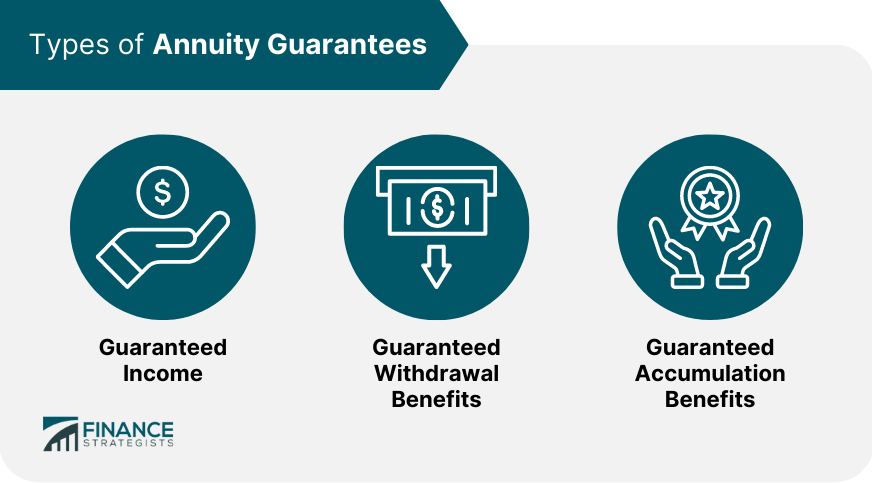Annuity guarantees are features built into annuity contracts that ensure a minimum level of income, accumulation, or withdrawal benefits for the annuitant, regardless of market conditions or life expectancy. These guarantees provide financial security for retirees by offering a stable income stream, protecting against longevity risk, and preserving their principal investment. The three main types of annuity guarantees are guaranteed income, guaranteed withdrawal benefits, and guaranteed accumulation benefits, each designed to address specific retirement needs and financial goals. Guaranteed income is a core feature of annuities that ensures a steady stream of income for the annuitant, regardless of market fluctuations or investment performance. Fixed annuities provide a guaranteed income for a specified period or the annuitant's lifetime. The income amount is determined at the outset of the contract and remains constant throughout the payment period. Variable annuities offer investment options that can potentially grow over time. To provide a guaranteed income stream, these annuities can include optional riders, such as a guaranteed minimum income benefit (GMIB), which ensures a minimum level of income regardless of investment performance. Guaranteed withdrawal benefits allow annuitants to withdraw a specific percentage of their investment each year without depleting their principal. A Guaranteed Minimum Withdrawal Benefit (GMWB) guarantees that the annuitant can withdraw a minimum percentage of their initial investment each year, regardless of investment performance. If the annuity's value falls below the initial investment, the insurance company will continue to make the guaranteed withdrawal payments. A Guaranteed Lifetime Withdrawal Benefit (GLWB) offers a similar benefit to the GMWB but guarantees the withdrawal payments for the annuitant's lifetime. This feature provides a lifetime income stream while preserving the principal investment. Guaranteed accumulation benefits protect the annuitant's investment, ensuring that the annuity's value will not fall below a certain level. A Guaranteed Minimum Accumulation Benefit (GMAB) guarantees that, after a specified period, the annuity's value will be at least equal to the total amount of premiums paid, regardless of investment performance. A Guaranteed Minimum Maturity Benefit (GMMB) ensures that, at the end of the annuity's accumulation phase, the annuity's value will be at least equal to a predetermined amount, regardless of investment performance. The length of time the guarantee is in effect can vary, depending on the specific annuity contract. Some guarantees last for a set number of years, while others may last for the lifetime of the annuitant. The annuitant's age and health can impact the cost and availability of annuity guarantees. Generally, older individuals and those with health issues may face higher costs for guarantees or may be ineligible for certain types of guarantees. While annuity guarantees are designed to protect the annuitant from poor investment performance, the actual value of the annuity and the income it provides can still be influenced by the performance of the underlying investments. Annuity guarantees come with additional fees and expenses, which can reduce the overall return on the annuity. These fees may include rider charges, mortality and expense risk charges, and administrative fees. Annuity guarantees help protect against the risk of outliving one's savings by providing a guaranteed income stream for a specified period of the annuitant's lifetime. Annuity guarantees provide a predictable and stable source of income, regardless of market fluctuations or investment performance. Guaranteed withdrawal and accumulation benefits help protect the annuitant's principal investment, ensuring that their initial investment is not depleted due to market downturns or poor investment performance. Annuities offer tax-deferred growth, allowing the annuitant's investment to grow without being subject to taxes until the funds are withdrawn. The financial strength of the issuing insurance company backs annuity guarantees. If the insurer becomes insolvent or unable to meet its obligations, the annuitant's guarantees may be at risk. Fixed annuity payments may not keep up with inflation, which can erode the purchasing power of the annuitant's income over time. Annuities often come with surrender charges, which can make it expensive to access funds in the early years of the contract. Additionally, withdrawal benefits may be subject to certain restrictions and limitations. Annuity guarantees come with additional fees, which can reduce the overall return on the annuity. Surrender charges can also make it expensive to exit the annuity contract early. When considering annuity guarantees, comparing different annuity products and their associated costs, benefits, and features is essential. Before purchasing an annuity, it's crucial to research the financial strength and credit rating of the issuing insurance company to ensure they can fulfill their obligations and guarantees. A financial advisor can help assess an individual's financial goals, risk tolerance, and retirement needs and recommend suitable annuity products with appropriate guarantees. Annuity guarantees offer a valuable means of securing financial stability during retirement by providing a predictable income stream, protection against longevity risk, and preservation of principal investment. However, it is crucial to consider the various types of guarantees available carefully, their associated costs and fees, and the potential risks and limitations, such as credit risk, inflation, and limited liquidity. Given the complexity of annuity products and the importance of choosing the right guarantees for your unique financial situation, working with an experienced insurance broker is highly recommended. An insurance broker can help you navigate the vast array of annuity options, assess the financial strength of insurance companies, and tailor a product that aligns with your financial goals and retirement needs.What Are Annuity Guarantees?
Types of Annuity Guarantees
Guaranteed Income
Fixed Annuities
Variable Annuities With Guaranteed Income Riders
Guaranteed Withdrawal Benefits
Guaranteed Minimum Withdrawal Benefit
Guaranteed Lifetime Withdrawal Benefit
Guaranteed Accumulation Benefits
Guaranteed Minimum Accumulation Benefit
Guaranteed Minimum Maturity Benefit

Factors Affecting Annuity Guarantees
Duration of the Guarantee
Age and Health of the Annuitant
Investment Performance
Fees and Expenses

Benefits of Annuity Guarantees
Protection Against Longevity Risk
Predictable Income Streams
Preservation of Principal
Tax-Deferred Growth
Risks and Limitations of Annuity Guarantees
Credit Risk of the Issuing Insurance Company
Inflation Risk
Limited Liquidity
High Fees and Surrender Charges

Evaluating Annuity Guarantees
Comparing Annuity Products
Assessing the Financial Strength of Insurance Companies
Working With a Financial Advisor
Conclusion
Annuity Guarantees FAQs
An annuity guarantee is a feature built into an annuity contract that ensures a minimum level of income, accumulation, or withdrawal benefits for the annuitant, regardless of market conditions or life expectancy. It provides retirees with financial security by offering a stable income stream, protection against longevity risk, and preserving their principal investment.
Three main types of annuity guarantees are guaranteed income, withdrawal benefits, and accumulation benefits. Guaranteed income ensures a steady stream of income, while guaranteed withdrawal benefits allow annuitants to withdraw a specific percentage of their investment each year. Guaranteed accumulation benefits protect the annuity's value from falling below a certain level.
Annuity guarantees provide a safety net for annuitants by ensuring a minimum level of income, withdrawal, or accumulation benefits, regardless of how the underlying investments perform. This helps protect annuitants from the negative impacts of market fluctuations and poor investment performance, providing them with financial stability during retirement.
Some risks and limitations of annuity guarantees include the credit risk of the issuing insurance company, inflation risk, limited liquidity due to surrender charges, and high fees associated with the guarantees. It's essential to carefully consider these factors when evaluating annuity guarantees as part of a retirement plan.
Consulting with an insurance broker is crucial when considering annuity guarantees because they can help you navigate the complex world of annuity products, assess the financial strength of insurance companies, and recommend suitable annuity products with appropriate guarantees tailored to your financial goals and retirement needs. This ensures that you make the most informed decision possible for a secure and comfortable retirement.
True Tamplin is a published author, public speaker, CEO of UpDigital, and founder of Finance Strategists.
True is a Certified Educator in Personal Finance (CEPF®), author of The Handy Financial Ratios Guide, a member of the Society for Advancing Business Editing and Writing, contributes to his financial education site, Finance Strategists, and has spoken to various financial communities such as the CFA Institute, as well as university students like his Alma mater, Biola University, where he received a bachelor of science in business and data analytics.
To learn more about True, visit his personal website or view his author profiles on Amazon, Nasdaq and Forbes.











